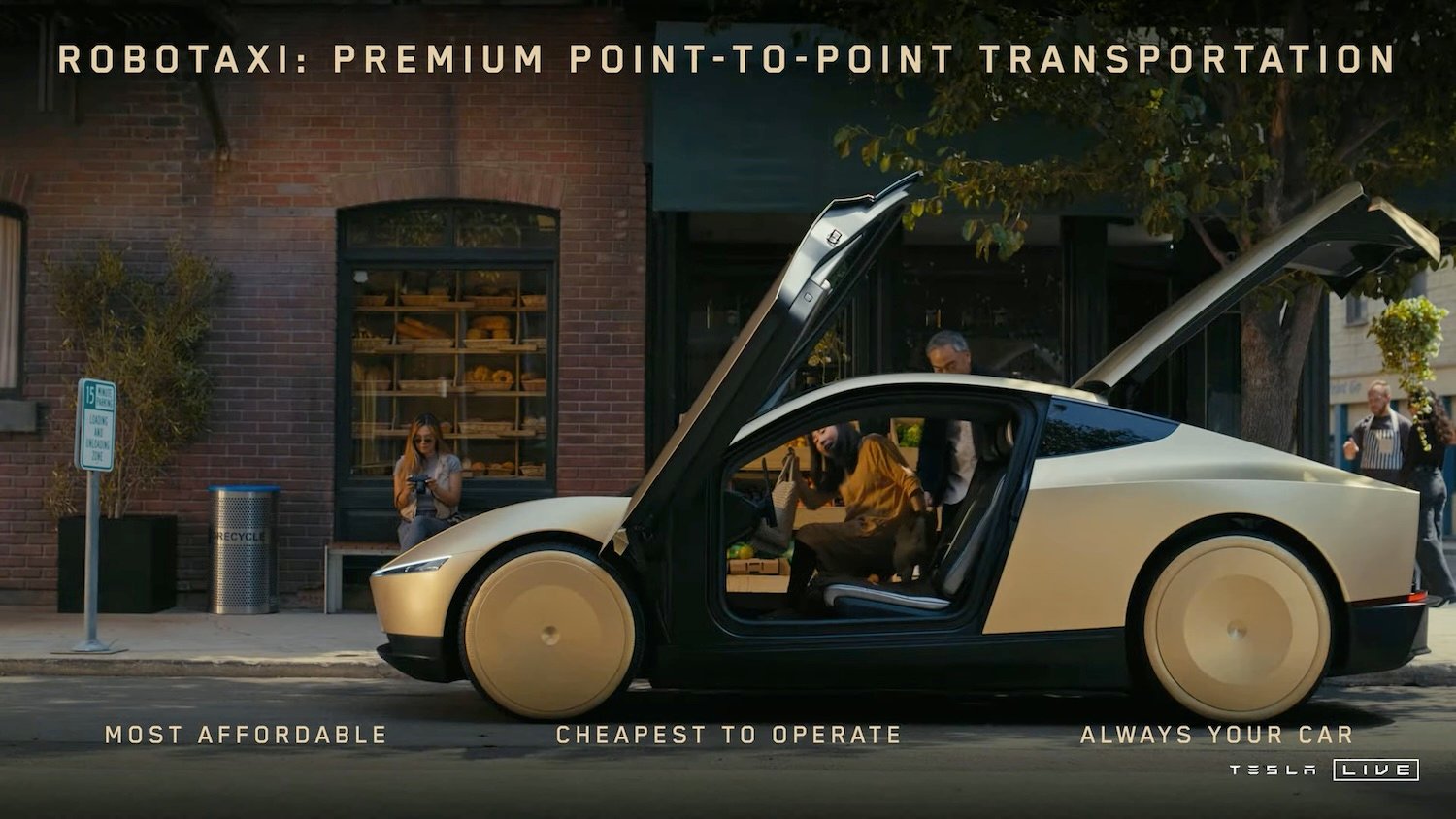Anyone else expecting a $100,000 “RoboBeast” in eight years and no mention of the $30,000 version ever again?
Like all techbros, Elon wants to paint himself as some kind of visionary genius. Instead they’re all just anti-regulatory right-wingers who just poorly regurgitate better people’s ideas. Elon’s already run this playbook before so we know he’s gonna do it again.
This is what I don’t get, I can also just say ‘visionary’ things by just opening any sci-fi book and pointing at a random page and claiming that I want to make that.
The hard part isn’t envisioning cool sci-fi concepts like self driving cars, colonized planets, ai servants, and life like VR. The hard part is actually doing them.
Well FSD is just right around the corner after all!
But in all seriousness, if his shitty candidate and party he endorses wins, they honestly probably will be on the roads in a few years time.
All he’s doing is making worse trains and busses. This isn’t innovative. Its a waste of fucken time. Make trains and busses.
Respectfully, I don’t want to see any trains or buses made under his guidance.
Fun fact, there’s a Tesla semi truck
My roomie is a trucker. He has laughed so much at the Tesla semitruck because it kind of fails at everything a truck is meant to do.
Technically, it’s far less explosive than a gasoline powered vehicle. However, batteries are very hard to extinguish if they catch fire.
Any fires are the product of a technical malfunction, and those are very easy to either mitigate, and, especially, engineer beyond.
Gasoline will always be flammable, and using it as a fuel source will always present certain concerns and risks. Measured against battery technology, however, it’s kind of a no-brainer as to which is much more safe.
Even Toyota’s hydrogen fuel cells (unquestionably more explosive than any battery or gasoline powered vehicle) are now technically safer than gasoline powered vehicles, just because of their amazing containment pods for the hydrogen fuel. Again, this sort of thing is just an engineering problem, not a problem with developing new resources and/or new techniques of harnessing their energy output.
The robot taxi and the bus thing both depend on FSD working well, so maybe they’ll be ready in like 20 or 30 years.
Although skeptical, and especially disliking Elon musk, this is merely speculative. It could take five years, or it could take 25 years. We just don’t know yet. However, unlike fusion, we’ve never achieved FSD yet. But, like fusion, I’m sure we will.
Just not yet, and, I hope, not a product of an Elon Musk company.
Well according to Elon FSD is going to be ready “next year” for the last 8 years or so. I wish he would swallow his pride, admit he was wrong, and start using lidar and other types of sensors.
We just have to apply Leon math. He says 2-3 years, so that’s 7 to 10 in reality. It will also cost 5x what is expected and be missing 60% of features at launch. Plus it’ll have new features, like it will have a steering wheel and peddles and require driver input every 15 miles or so.
And the 40% of features that are there will only work half the time.
And be locked behind a subscription
All Tesla shareholders and twitter users asked to hold their breath until then.
The stock dropped 7% so I guess not everyone is
“Always your car,” is corporate speak for “you will be liable for whatever it does.”
These things and the trucks are so damn ugly… Who the hell watched 80s sci-fi and was like “Yes! Give me that aesthetic.”
Not even good 80s sci-fi. That truck looks like it came from a low-budget Star Wars or Mad Max ripoff.
It’s because they do it so poorly. It’s cost-cutting masquerading as innovation and minimalism. This style has been done well by Giorgetto Giugiaro in the 80s. The Delorean and Maserati Boomerang are undoubtedly beautiful (though certainly a product of their time). These are just cheap cosplay pulling at tech-bro nostalgia.
Right beside full self driving? Is this like the classic “fusion is just 5 years away”?
Hey, at least we have actually accomplished (edit: net-positive) fusion. 10-20 years before the first commercial plant comes online, but fusion is a technology which now exists. This is extremely awesome. Honestly, I never thought I’d see it. But, it’s here, it exists, and now the distance between today and when the first power plant comes online is just a matter of scaling the tech upwards.
Full, autonomous self-driving cabs - especially from Tesla - on a massive scale… not so much.
Question for you, when you say that we’ve accomplished fusion, do you mean fusion that produces more power than took to generate it? Or simply the act of fusing atoms together in a reactor (vs the uncontained fusion present in thermonuclear bombs)? If it’s the former, then like, holy shit, that’s actually been accomplished‽ Like, I know NIF had their whole thing with breakeven fusion a couple of years ago, but that was only counting the energy that made it to the hohlraum, not all the energy that was lost powering the lasers and shit. When you factor all of that in (like you’d need to for realistic power generation) then it’s very far away from breakeven generation. It’s still an incredible breakthrough and will help us figure out fusion energy, but it’s not a practical means of energy generation at this time. Did something else happen that I missed‽
If it’s the latter, then we’ve actually been fusing atoms together in reactors since the 1950s. In fact, there’s a community of people who build small fusion reactors as a hobby! I learned about this a few years ago when a 16 year old made the news by being the youngest person to build their own reactor. The main site I know of is https://www.fusor.net/
Previous commenter may have been referring to this, where Lawrence Livermore National Laboratory announced producing more energy than the laser energy put into it https://www.energy.gov/articles/doe-national-laboratory-makes-history-achieving-fusion-ignition
I appreciate the link!
I forgot bout this achievement in 2022!
Yes, net-positive fusion was achieved in August of last year:
Scientists achieve net energy gain breakthrough with nuclear fusion
Of course, this is going to take a decade or two to scale up to commercial energy production, but net-positive fusion is real and does exist.
Ah, okay, that’s what I was referring to with NIF. They absolutely have generated more power than they put in, but only in a way that is scientifically interesting. If you only consider the energy flowing into the hohlraum, then more energy was produced, which is crazy cool! They also achieved true ignition which is great. We’ve never been able to get things hot enough and squozed enough for long enough to be able to directly observe that in a controlled setting. The fact that they can now just do that means the they can experimentally probe where the boundaries are and find the cheapest way for us to get to ignition.
However, they got the energy to the hohlraum using lasers. Those lasers (and all of the equipment around them) required (I think) three orders of magnitude more power to generate the laser impulse that triggered fusion. A productive fusion reaction did occur, but it absolutely wasn’t productive enough to make up for all the power required to generate the laser pulse. Making lasers that can output at the required power levels and frequencies without all of the waste (i.e. 2.5 MJ of electricity to laser results in 2 MJ laser output) is a Hard Problem™ and is probably impossible with our current understanding of physics.
When you made your comment, I wondered if someone had achieved breakeven using a tokamak or some other form of magnetic confinement setup. Inertial confinement fusion is great for research but not practical for power generation, whereas magnetic confinement fusion is probably where the future is.
ICF is really good at putting the squoze on stuff, because the things you want to fuse are all stuffed in a tiny hohlraum and you’re zorching it with a shitload of giant friggin lasers. Magnetic confinement fusion used in tokamaks occurs much more gradually by magnetically heating and containing plasmas. The nice thing about tokamaks is that they just constantly generate heat. With modern superconducting magnets, the infrastructure efficiency is also pretty decent, giving them a chance at truly generating more power than they use when you take the entire reactor into consideration.
Jesus that’s a lot of words. I should go do my damn job instead of distracting myself talking about fusion. Sorry for the brain dump.
I apologize— my intent wasn’t to be misleading, just highly optimistic about the future.
No worries, I didn’t think you were trying to mislead! I’m also very hopeful for fusion and I like to read about it. I don’t know if magnetic confinement systems will be able to reach the temperatures and pressures required for ignition (versus those just for fusion) soon, but technological progress certainly has a tendency towards jumping forwards unexpectedly!
“Magnetic confinement”… just hearing the term in real-world use get me all excited that Star Trek and real life are finally starting to cross over.
Although Star Trek also predicted that the next 30-50 years are gonna suck the hard one.
Edit: at least we’re not trying to screw around with matter/antimatter power production. There was an entire episode of Star Trek: Voyager about how that is an absurdly, ridiculously dangerous technology for power production on a planetary scale, even in the 24th century.
Er, not really with fusion actually, unless you just mean “have made atoms fuse regardless of if it generates net energy or not” in which case we’ve had it for decades. We have managed net energy production if you compare the output of a very powerful laser used to compress the fuel to the energy of the resulting reaction, but crucially, the laser in question isn’t perfectly efficient, and only a fraction of the electrical energy put in is turned into laser energy in the beam. This means that we still don’t have net electricity production, and even once we finally get that, getting the tech efficient enough to produce enough electricity to be cost competitive will be a tough ask, especially as electricity from solar in particular has been going down in price of late.
Yes, net-positive fusion was achieved in August of last year:
Scientists achieve net energy gain breakthrough with nuclear fusion
Obviously, this will take a decade or two to develop into a viable commercial energy source, but the barrier has been overcome with regards to net-positive fusion.
That’s what I was talking about regarding the lasers. As far I understand that result, it’s net energy in a physics sense, as in the reaction itself produced more energy than put in, but because the energy put in isn’t electricity itself, and the conversion process between electricity and energy in the laser is inefficient, the entire machine as a whole isn’t energy positive, just the reaction. It can’t yet be used as an electric generator, unless the reporting I saw on this at the time was inaccurate
I get what you’re saying, and you’re right on many ways (especially wrt the energy conversion), but the barrier to producing net-positive fusion has been overcome. And it’s just a matter of scaling it up at this point— which includes overcoming many new hurdles such as (more) efficient energy conversion.
But none will be so insurmountable as the initial creating of net-positive reactions. That was the big one, and we did it.
I guess my objection then is that I tend to take “just scale it up” to imply “all the tech development hurdles are done, we have a working prototype of the machine we want to build, we just need to construct a physically larger one”, and so was taking the process of improving the efficiency of the reaction to useful levels and figuring out how to make a significantly more efficient laser as “we don’t have this technology done yet, because we still have these milestones left”. In other words, we’re just arguing from confusion over different definitions of a word rather than the reality of what those words are referring to
I never claimed that all of the development hurdles were done. Far from it. But if you wish to object to my phrase, “just scale it up“, then you can certainly criticize me for oversimplifying the matter.
Its been a decade away since 80’s. We should have been working on MSR and make them sustainable before getting to the next stage
It’s not a binary, not really.
We have achieved net-positive fusion as of last year. That’s the achievement we needed to move to the next stage, and it’s the one which was always a hopeful “maybe”. But we finally did it. It’s imperfect and needs to be refined and scaled up (another Herculean effort, to be sure), but we’ve crossed from the “is it even possible?” to the “we proved it can be done, now let’s make this into a practical technology.”
So, when scientists claim 10-20 years from now, it’s no longer hopeful speculation but a well-educated projection based on current development.
Meh, that is downplaying a significant hurdle being overcome.
True, but also a concise description of hurdles yet to come.
We’ve accomplished fusion for 70 years. Problem is it’s always been 20 years away from being viable for general use.
We never achieved net positive fusion until last August.
https://www.power-technology.com/news/scientists-achieve-second-nuclear-fusion-breakthrough/
Livermore Lab had net positive from inertial confinement in the early 2000’s, but that tech is more for bomb making than power plants.
Yeah, magnetic confinement is very Star Trek, but I guess we’re finally entering the window of Star Trek history.
Magnetic confinement may be a simpler tech, but it’s still nowhere close to being able to contain a fusion reaction. Yet.
And that may turn out to be the next hurdle to overcome. Still, far less difficult than proving net-positive fusion can be produced artificially (and, especially, by humans).
In the video, when he’s talking about the robot Optimus, he claims that at scale this will cost $20-30K and goes on to say “this will be the biggest product ever of any kind” and “everyone of the 8 billion people one earth will want their Optimus buddy”.
Dude. Most people on this planet can barely afford a $1,000 smart phone.
“Let them eat cake”
— another famous rich person, shortly before she got what she deserved.
https://en.m.wikipedia.org/wiki/Let_them_eat_cake
Appears not to be the case. I was curious about the full context, and that context is that it almost certainly didn’t actually happen.
Hush, you ;)
But, yes, Marie Antoinette probably never said it. Jean-Jacques Rousseau very likely made it up.
Nonetheless, it’s prescient legend.
“this will be the biggest product ever of any kind” and “everyone of the 8 billion people one earth will want their Optimus buddy”.
Dude. Most people on this planet can barely afford a $1,000 smart phone.
First, there are a shockingly high number of people walking around with a $1k smart phone, but I think that speaks more to people buying on credit.
Sadly if a company can replace a worker with a $30k robot, he won’t be wrong that lots would be sold. I have serious doubts these will be replacing humans in the short term.
Add it to the list.
I love that at least some of the press is finally calling Elon on his bullshit. The ArsTechnica review of this event was particularly delicious.
I’ll cut my fucking legs off and buy a wheelchair and roll my ass around before I ever get one of those.
Fuck Musk
It’ll be ready next week, I promise.
If things are at least progressing somewhat he predicts next year. For Musk to say 2-3 years means the project has hit a brick wall and they’re desperate.











